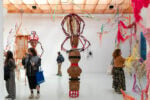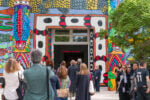The Material Body of Art
.jpg)
Mostra collettiva
Comunicato stampa
A plus A Gallery in Venice is pleased to announce the exhibition The Material Body of Art, which will be inaugurated on December 13th, 2016 at 1:00 p.m.
On December 13th, from 11:00 a.m. to 12:30 p.m., teatrino di Palazzo Grassi, a venue of Pinault Foundation next to the Gallery at Vaporetto Stop San Samuele, will host a roundtable to analyze the performance as a phenomenon in Eastern Europe. Artists and curators alike will encounter a discussion on art forms born in a system such as the one offered by former Yugoslavia, for instance.
artists: Jiří Kolář | Běla Kolářová | Milan Knížák | OHO, Marko Pogačnik | Irwin | Matej Stupica | Mladen Miljanović | Lenka Đorojević | Dalibor Chatrný | Ladislao Novak
The exhibition will take place parallel to the third edition of the Venice International Performance Week. At this occasion, A plus A Gallery has been invited to participate with the curatorial direction of a chapter dedicated to performance artists from Eastern European countries. Under the title Fragile Body – Material Body, both Palazzo Mora and Palazzo Michiel will host the event in Venice from December 10 – 17, 2016.
The Material Body of Art is a group exhibition at A plus A Gallery that will bring together works from Czech artists Jiří Kolář, Běla Kolářová, and Milan Knížák; from Slovenian artists OHO, Irwin, and Matej Stupica; from Bosnian artist Mladen Miljanović; and from the Montenegrin Lenka Đorojević. The production of these artists is united by their use of collage. In this context, this technique can be identified as a art form that – starting from the 1960s – became typical of the aesthetics in Eastern European countries as it sought a particular link with the life of a totalitarian regime, which in itself contributed to the development of a collective imaginary expressed through the production of art works with the use of everyday objects.
The departing point of the exhibition is the environment developed in the 1960s, a research-based atmosphere in which the artists of the Czech avant-garde affirmed themselves as refined individuals but at the same time as determined opponents of a society that could be confronted through irony. The exhibition also includes Slovenian artists of the Irwin group. During the 1980s, these artists experienced the totalitarian system as a form of transition, up until the arrival of younger artists: the Slovenian Matej Stupica, whose work evolves parallel to that of the Montenegrin Lenka Đorojević and the Bosnian Mladen Miljanović.
The exhibition will feature works that identify those that have become icons of mass consumption taking place on the outside of Western capitalism and, at the same time, in the context of a worldwide mass consumption as such. It is about works in which both reality and the universalism of consumerism deeply penetrate the structure of artistic production. The collage technique applied on these artworks creates a dialogue and a sense of tension with the act of artistic performance, as well as with the political and economical reality of time. The use of this technique reveals the everyday physical reality of the artist, thus becoming a reminder of a life once lived. Actually, it is not surprising that those artists to have chosen the collage as a medium of expression are the same ones who have often come across with the art of the performance.
The third edition of the Performance Art Week offers the possibility of creating a confrontation between two forms of artistic expression: on one hand, the performance that utilizes the human body to powerfully irrupt into reality itself; and on the other hand, the collage as a means that allows everyday human life and its objects to penetrate into art, just as it happened with Dada.
A special thanks is dedicated to Miroslava Hájek for her collaboration.



